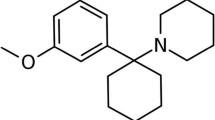Abstract
A 32-year-old male was found dead on the couch in his flat. Several pieces of paraphernalia for the use of illicit drugs were located on the table in front of his body. The occasional consumption of heroin and cannabis products was known. Toxicological analyses of blood, urine, and of his long (88 cm) dreadlocks were performed after autopsy. General, unknown screenings of femoral vein blood and urine were performed using different extractions, gas chromatography/mass spectrometry (GC/MS) or high-performance liquid chromatography-diode array detection. A possible influence by alcohol was determined by gas chromatography/flame ionisation detection and an alcohol dehydrogenase method. The dreadlocks were washed, segmented in 83 parts (each ~1 cm length) and pulverised using a pebble mill. Quantitative determination of illicit drugs was performed using GC/MS (selected ion monitoring). Investigation of the femoral vein blood resulted in the detection of morphine (71.1 µg/L), 6-acetylmorphine (7.4 µg/L), and codeine (9.8 µg/L). These substances and 11-nor-9-carboxy-Δ9-tetrahydrocannabinol were also detected in urine. Alcohol concentrations in blood and urine were 2.31 and 3.01 ‰, respectively. Investigation of the segmental dreadlocks revealed concentration profiles for Δ9-tetrahydrocannabinol (≤0.65 µg/g), heroin (≤0.44 µg/g), morphine (≤1.02 µg/g), 6-acetylmorphine (≤1.13 µg/g), and codeine (≤0.32 µg/g). Strong correlations among morphine, 6-acetylmorphine, and codeine have been observed in the twelve most proximal hair segments. The consumption of heroin increased clearly in this time period. In summary, a discontinuous, long-term, illicit drug abuse and fatal intoxication with heroin and alcohol was verified by the analysis of these very long dreadlocks.






Similar content being viewed by others
References
Curtis J, Greenberg M (2008) Screening for drugs of abuse: hair as an alternative matrix: a review for the medical toxicologist. Clin Toxicol 46:22–34
Musshoff F, Lachenmeier K, Lichtermann D, Madea B (2009) Cocaine and opiate concentrations in hair from subjects in a heroin maintenance program in comparison to a methadone substituted group. Int J Legal Med 123:363–369
Kintz P (2004) Value of hair analysis in postmortem toxicology. Forensic Sci Int 142:127–134
Pragst F, Balikova MA (2006) State of the art in hair analysis for detection of drug and alcohol abuse. Clin Chim Acta 370:17–49
Tagliaro F, De Battisti Z, Smith FP, Marigo M (1998) Death from heroin overdose: findings from hair analysis. Lancet 351:1923–1925
Drummer OH (2004) Postmortem toxicology of drugs of abuse. Forensic Sci Int 142:101–113
Darke S, Hall W, Kaye S, Ross J, Duflou J (2002) Hair morphine concentrations of fatal heroin overdose cases and living heroin users. Addiction 97:977–984
Sporkert F, Rentsch D (2004) Schnelle alternative Methylierung zum Nachweis von Cannabinoiden in Serum, postmortalem Blut und Haar unter Verwendung von Trimethylsulfoniumhydroxid (TMSH) als Derivatisierungsmittel. GTFCh—Symposium 2003—Ausgewählte Aspekte der Forensischen Toxikologie. Verlag Dr. Dieter Helm, Fritz Pragst und Rolf Aderjan (Hrsg.), pp 334–342, ISBN: 3-923032-16-1
Kauert G, Röhrich J (1996) Concentrations of Δ9-tetrahydrocannabinol, cocaine and 6-monoacetylmorphine in hair of drug abusers. Int J Legal Med 108:294–299
Rothe M, Pragst F (1995) Solvent optimization fort the direct extraction of opiates from hair samples. J Anal Toxicol 19:236–240
Madea B, Musshoff F (2004) Haaranalytik—Technik und Interpretation in Medizin und Recht. Deutscher Ärzte-Verlag GmbH: 148, ISBN: 3-7691-0437-4
Lee S, Cordero R, Paterson S (2009) Distribution of 6-monoacetylmorphine and morphine in head and pubic hair from heroin-related deaths. Forensic Sci Int 183:74–77
Pépin G, Gaillard Y (1997) Concordance between self-reported drug use and findings in hair about cocaine and heroin. Forensic Sci Int 84:37–41
Acknowledgments
The authors wish to thank Mr. Robert Einsle for his excellent work during the sample preparations and measurements.
Author information
Authors and Affiliations
Corresponding author
Ethics declarations
Conflict of interest
There are no financial or other relations that could lead to a conflict of interests.
Ethical approval
This article does not contain any studies with living human participants or animals performed by any of the authors. The analyses of toxic substances from the cadaver were permitted by judicial authorities with an official document.
Rights and permissions
About this article
Cite this article
Kegler, R., Büttner, A., Nowotnik, J. et al. Postmortem investigation of 88-cm-long dreadlocks for drugs of abuse: an unusual case report in the northeast of Germany. Forensic Toxicol 34, 419–424 (2016). https://doi.org/10.1007/s11419-016-0318-9
Received:
Accepted:
Published:
Issue Date:
DOI: https://doi.org/10.1007/s11419-016-0318-9




